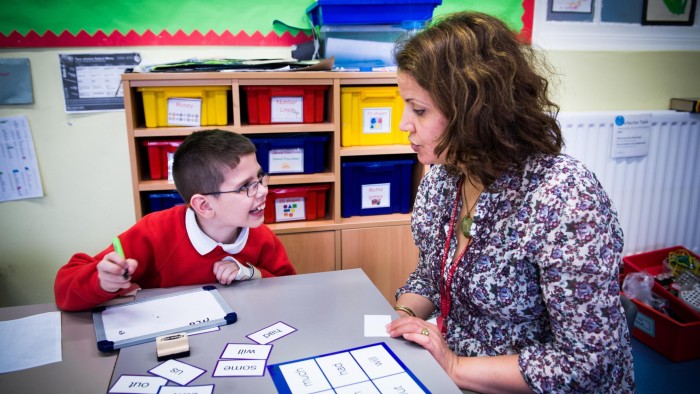Unlock the Editor’s Digest for free
Roula Khalaf, Editor of the FT, selects her favourite stories in this weekly newsletter.
One-fifth of children in England require special needs assistance in schools, while one in twenty now has dedicated support plans funded by councils that are already battling ballooning costs, figures show.
The number of children in England with an education, health and care plan (EHCP) increased by 11 per cent this year to 482,640, according to official data published on Thursday.
The figure is a record high, and has doubled in the past decade, piling additional financial pressure on to local councils that have to fund the plans.
More than 5 per cent of children now have an EHCP setting out the support they are legally entitled to receive from the state, while a further 14 per cent require special educational needs (SEN) support, but do not have a plan.
Analysts said the sharp rise in demand was driven by growing recognition of certain conditions, adding that numbers and spending would continue to rise until the system was reformed.
Luke Sibieta, research fellow at the Institute for Fiscal Studies, said the rise was largely explained by increasing recognition of autistic spectrum disorder, ADHD, mental health problems, and speech and language needs.
“This is mostly down to greater identification of needs that were always there, rather than actual increases in need,” he said, adding that there was also a “clear incentive” for schools and parents to seek plans to guarantee extra resources.
The government has said it intends to reform the system by increasing the number of children supported within mainstream schools, potentially restricting access to EHCP for conditions such as ADHD and autism spectrum disorder.
The Treasury committed £760mn in Wednesday’s spending review to transform the system, but full details are not expected until the autumn. Since the election last year the government has announced a £1bn rise in high-needs funding and £740mn capital investment for councils to create more high-needs places.
Sibieta said reform could deliver “a better and more cost-effective system” but that it would take time to implement changes, meaning a continued rise in numbers and spending was likely.
Council leaders said they needed “urgent clarity” from the government, adding that half of county and unitary authorities could become bankrupt overnight when a temporary measure that kept special needs costs off their budget books expired in March 2026.
“We are now nine months away from a financial cliff edge,” said Tim Oliver, chair of the County Councils Network. “Councils need urgent clarity on how the government intends to manage these deficits.”
Reducing reliance on specialist placements and enabling more children with SEN to access support in mainstream schools was “key to a sustainable future”, he added.
Insufficient state capacity has left councils increasingly reliant on the private sector to deliver specialist support, with each place costing about £62,000 a year, relative to £24,000 in the state sector.
This has created a lucrative market with significant private equity backing and rapid growth. The number of private special schools increased 10 per cent in the year to January 2025, according to official figures published last week.
Education secretary Bridget Phillipson said: “Behind each one of these figures is a family desperately fighting for even the most basic support for their child, leaving a staggering number of parents exhausted while young people are denied precious help.”
She added that the government had “already taken the first steps to identify and meet children’s needs earlier in mainstream schools,” and “will deliver the reform that families are crying out for”.




